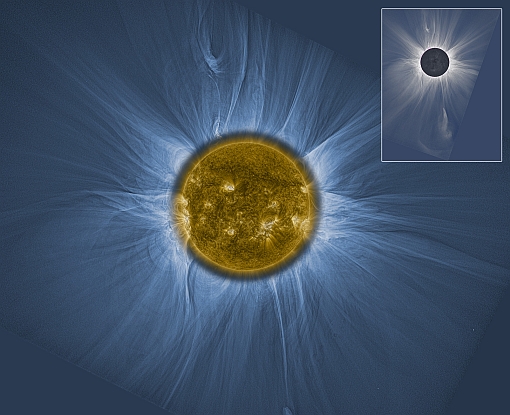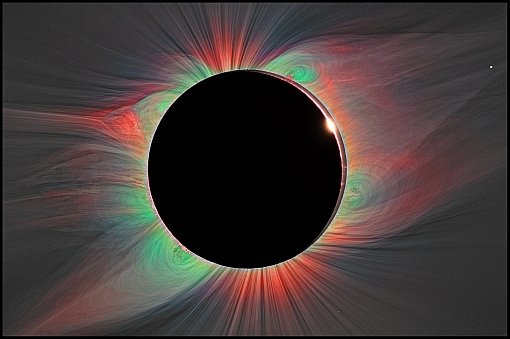| ☰ Menu | Solar Wind Sherpas |

Despite their short duration, total solar eclipses continue to provide unique opportunities to
explore the physical properties of the coronal plasma, the intricate expansion of the solar magnetic
field into space, and the development of plasma instabilities. Imaging and spectroscopy capture,
unequivocally, the instantaneous steady and dynamic states of the corona, over a distance range
of several solar radii starting from the visible solar surface. Ironically, such observations are
untenable from currently operating solar telescopes from space and from the ground.
One of the advantages of the visible wavelength range is that the coronal emission in the forbidden
lines as well as white light can be captured over several solar radii. This is shown in the example of
Figure 1, which is a composite of a multiwavelength SDO/AIA extreme ultraviolet observation with a white
light eclipse image taken at the same time during the total solar eclipse of 3 November 2013.
The almost perfect match between all the fine structures revealed in both images is quite striking,
in particular when one keeps in mind that one is taken in the EUV from space, and the other from the
ground with a relatively simple camera-lens system.

During the eclipse of 2015 the Solar Wind Sherpas International Team [2,3] plan to image the coronal emission in the Fe XI (789.2 nm) and Fe XIV (530.3 nm) lines, as well as in broad band white light. These lines have a peak ionization temperature of 1 and 2 MK, respectively. The example of Figure 2 is from observations made on August 2008, where the emission in Fe XI is shown in red and the Fe XIV in green. Note that envelope of the large prominence in the Northwest consists of the hotter Fe XIV material. The profile of these two lines will also be measured with a spectrometer along a 4 solar radii long slit whose position, parallel to the solar limb, will be moved radially outwards from the Sun during totality. Spectropolarimetric observations of a section of the corona will also be made in the near infrared Fe XIII 1074.7 nm line to infer the local direction and strength of the coronal magnetic field.
The combination of these observations should enable us to follow the physical properties of coronal structures at a spatial resolution of a few arcseconds, as well as the properties of the Fe10+ and Fe13+ ions through their measured intensities and line profiles.
References
[1] S. Rifai Habbal1, M. Druckmuller, H. Morgan, I. Scholl, V. Rusin, A. Daw, J. Johnson, and M. Arndt, Total Solar Eclipse Observations of hot Prominence shrouds, ApJ 719, 1362, 2010.
[2] S. R. Habbal, H. Morgan, M. Druckmuller, Exploring the Prominence-Corona Connection and its Expansion into the Outer Corona Using Total Solar Eclipse Observations, ApJ, 793, 119, 2014.
[3] M. Druckmuller, S. Habbal and H. Morgan, Discovery of a New Class of Coronal Structures in White Light Eclipse Images, ApJ, 785, 14, 2014